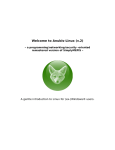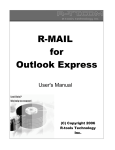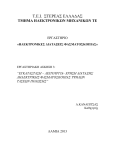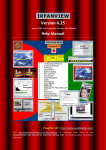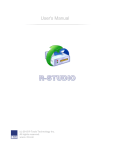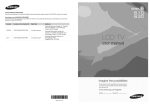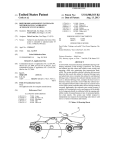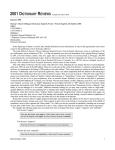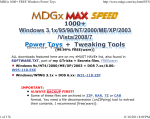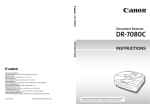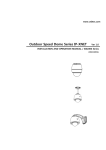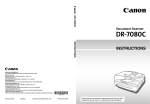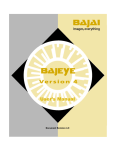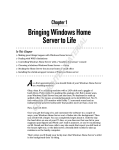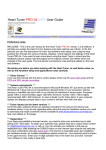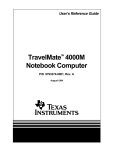Download Seagate File Recovery for Windows - R
Transcript
User's Manual (c) 2015 R-Tools Technology Inc. All rights reserved. www.r-tt.com © 2008-2015 R-tools Technology Inc. All rights reserved. No part of this User's Manual may be copied, altered, or transferred to, any other media without written, explicit consent from R-tools Technology Inc.. All brand or product names appearing herein are trademarks or registered trademarks of their respective holders. R-tools Technology Inc. has developed this User's Manual to the best of its knowledge, but does not guarantee that the program will fulfill all the desires of the user. No warranty is made in regard to specifications or features. R-tools Technology Inc. retains the right to make alterations to the content of this Manual without the obligation to inform third parties. Contents I Table of Contents I Introduction to R-Undelete 1 1 R-Undelete ................................................................................................................................... Features 1 2 System Requirements ................................................................................................................................... and Installation Notes 2 3 Contact Information ................................................................................................................................... and Technical Support 2 II Data Recovery Using R-Undelete 3 1 Recover Lost ................................................................................................................................... Files from Existing Logical Disks 4 Searching for a File .......................................................................................................................................................... 10 Finding Previous.......................................................................................................................................................... File Versions 12 File Masks .......................................................................................................................................................... 13 Regular Expressions .......................................................................................................................................................... 14 Preview ing Files.......................................................................................................................................................... 14 Detailed Scan .......................................................................................................................................................... 17 2 Recover................................................................................................................................... Lost Files from Deleted/Corrupted Logical Disks/Partitions 26 III Disk Image 28 IV Hexadecimal Viewer 30 V Data Recovery Issues 32 VI Extended Information Recovery 34 VII S.M.A.R.T. data 34 Index 36 © 2015 R-Tools Technology, Inc 1 R-Undelete Manual Introduction to R-Undelete I R-Undelete is a powerful and cost-effective undelete and data recovery software. Empowered by the new unique data recovery technologies, it is the best data recovery solution for recovering files from FAT12/16/32, NTFS, and NTFS5 (created or updated by Windows NT 4.0, 2000, XP, 2003, Vista, 7.) logical disks. Flexible parameter settings give you absolute control over the data recovery. R-Undelete Features System Requirements and Installation Notes Contact Information and Technical Support Data Recovery Using R-Undelete Disk Image Hexadecimal Viewer Data Recovery Issues Extended Information Recovery S.M.A.R.T. data 1.1 R-Undelete Features R-Undelete features: · Wizard-oriented interface. · Host OS: Windows XP, 2003, Vista, 7, 8/8.1, Server 2012, Windows 10. · Supported file systems: FAT12, FAT16, FAT32, NTFS, NTFS5 (created and updated by Windows 2000/ XP/2003/Vista/7/8/8.1, Server 2012, 10), ReFS. · Support for known file types. R-Undelete searches for files with known typical features of their structures allowing the user to search for files on devices with unknown files systems, including an HD, CD, DVD, floppy disk, Compact Flash Card, USB drive, ZIP drive, Memory Sticks, and other removable media. · Detailed scan process visualization. While searching an object, R-Undelete graphically shows items that have been found, including files of known types, FAT and NTFS MFT records, boot records, etc. · Dynamic disk support. · Creates image files for logical disks and hard drives. Such image files can be processed like regular disks. R-Undelete can scan objects while creating their images. · Recovers compressed files (NTFS, NTFS5). · Recovers encrypted files (NTFS5). · Recovers alternative data streams (NTFS, NTFS5). · Recognizes localized names. · Recovered files can be saved on any (including network) disks visible by the host operating system. · A hexadecimal disk and file viewer. · File preview. Most of the file types can be previewed to estimate recovery chances. · Support for S.M.A.R.T. (Self-Monitoring, Analysis and Reporting Technology) attribute monitoring. · Installation on a removable device. This feature is useful when lost files reside on a system disk and program installation may overwrite them making their recovery impossible. © 2015 R-Tools Technology, Inc Introduction to R-Undelete 2 R-Undelete recovers files: · That have been removed without Recycle Bin, or when Recycle Bin has been emptied; · Removed by virus attack or power failure; · From deleted or corrupted logical disks or partitions R-Undelete can create image files for a logical disk or hard drive. Such image files can be processed like regular disks. Images are very useful if there is a risk of total data loss due to hardware malfunction. If bad blocks are constantly appearing on a hard drive, the only way to save the data is to immediately create an image of that drive. All data search and recovery can be done from this image. 1.2 System Requirements and Installation Notes System Requirements · An Intel-compatible platform running Windows XP, 2003, Vista, 7, 8/8.1, Server 2012, Windows 10. · At least 32 MB of RAM, a mouse, and enough disk space for recovered files, image files, etc. · The administrative privileges are required to install and run R-Undelete under Windows /XP/2003/ Vista/7/8/8.1/Server 2012/Windows 10. Installation Notes NEVER install any software or write any data on the disk where lost data resides! Or you may damage or even completely lose the data. See the Data Recovery Issues topic for details. If the lost data resides on your system disk (usually C:): Create a portable version. You may create a portable version on any removable media. When installing R-Undelete, select Create portable version on the R-Undelete installation wizard and specify the device with removable storage. R-Undelete portable is installed in the R-Undelete folder in the device root. Also the autorun.inf file is created and any time the device is connected, R-Undelete will start automatically. If you do not want that, simply delete the autorun.inf file from the device and start R-Undelete portable by launch the rundelete.exe from the R-Undelete folder. Use another computer 1. Install R-Undelete on a second computer. 2. Disconnect the hard drive with the lost data from the computer where it has been hosted (the primary computer). 3. Connect the hard drive to the second computer. You may connect it as a second hard drive or use an HDDto-USB 2.0 adapter. 4. Run R-Undelete on the second computer and recover the data. Now you may reconnect the hard drive to the first computer. 1.3 Contact Information and Technical Support To obtain the latest version of R-Undelete, go to: Product Site: http://www.r-undelete.com/ Sales Department: [email protected] © 2015 R-Tools Technology, Inc 3 R-Undelete Manual R-Undelete Technical Support Team is available 24 hours a day, seven days a week, and has an average response time less than 4 hours. Tech. Support: [email protected] Send your support request to: http://www.r-tt.com/SupportRequest.shtml File Recovery FAQ: http://www.r-tt.com/File_Recovery_FAQ.shtml R-tt Forum: http://forum.r-tt.com II Data Recovery Using R-Undelete NEVER TRY TO SAVE RECOVERED FILES/FOLDERS TO THE SAME LOGICAL DISK WHERE THEY RESIDE!!! Or you may obtain unpredictable results and lose all of your data. See the Data Recovery Issues topic for details. You may start data recovery with R-Undelete directly from Windows Explorer. Right-click the disk in Windows Explorer and select Find recently deleted files with R-Undelete on the shortcut menu Note: If you try to start R-Undelete under an account without administrative rights, you will have to enter an administrative password on the User Account Control dialog box. Changing the program language You may select the language of R-Undelete. To do so, click the About button, then the Language button on the Copyright panel, and select an available language. Depending on your situation, you will need to: · Recover lost files from an existing logical disk · Recover lost files from a deleted logical disk · Create or load a disk image You make the selection on the Step1. Select disk panel © 2015 R-Tools Technology, Inc Data Recovery Using R-Undelete 4 Step1. Select disk panel 2.1 Recover Lost Files from Existing Logical Disks Note: If you have done all the operations listed below, but still cannot find your lost files, you need to perform an exhaustive search for the files on the logical disk. To recover deleted files from a logical disk, 1 Select the logical disk on the R-Undelete Step1. Select disk and click the Next button, or double-click the disk. Step1. Select disk panel You may start data recovery with R-Undelete directly from Windows Explorer. Right-click the disk in Windows Explorer and select Find recently deleted files with R-Undelete on the shortcut menu Note: If you try to start R-Undelete under an account without administrative rights, you will have to enter an administrative password on the User Account Control dialog box. © 2015 R-Tools Technology, Inc 5 2 R-Undelete Manual Select Fast search for recently deleted files on the Step 2. Select action panel and click the Next button Step 2. Select action panel > R-Undelete will change its panel showing the disk's folders/files structure R-Undelete analyzes data on the disk and displays all files which records have been found. Then deleted files, which records still remain, can be recovered. If files have not been found, that means that their records have been deleted. To find such files, Detailed Scan is required. Please note that R-Undelete shows only those files/folders that match a specified file mask . Step 3. Select files for recovery panel Panel view options You may select which columns will be shown on the Contents pane. Right-click the table header and select the required ones. You may also arrange the data as required. Select the required arrangement on the Mark files for © 2015 R-Tools Technology, Inc Data Recovery Using R-Undelete recovery 6 panel. Buttons Find Click this button to find a particular file/folder. R-Undelete searches for files only among files specified by a File Mask. Find Next Click this button to find the next object specified in the Find dialog window. Find Previous Click this button to find the previous object specified in the Find dialog window. File Mask Click this button to specify a file mask. Up Click this button to move highlighting one folder up. Folders panel Deleted folder Marked folder (all child objects in this folder are marked) Partially marked folder (some child objects in this folder are marked) Cross-linked deleted folder (A FAT folder containing data which also belongs to other FAT folders.) Questionable Cross-linked deleted folder (A FAT folder found by R-Undelete , but with apparently invalid content.) You may also arrange the data as required: by their extensions, creation/modification time, or as a real file structure Files panel: Deleted file: Marked deleted file Selected deleted file The Find Results panel. Appears when File Search has been performed © 2015 R-Tools Technology, Inc 7 R-Undelete Manual Log panel: 3 Select file(s)/folder(s) to recover and click the Next button Mark a file/folder to recover by clicking the box left to the object, or select Mark on the shortcut menu. You may mark several files/folders in different parent folders. You may mark all objects in the folder by selecting Mark All on the shortcut menu. To unmark an object, click the box left to the object once more or select Unmark on the shortcut menu. You may unmark all objects in the folder by selecting Unmark All on the shortcut menu. R-Undelete can search for a particular file. Go to the Searching for a File topic for details. File content may be previewed before recovery. Go to the Previewing Files topic for details. If you do not find files that you want to recover: Sometimes R-Undelete can find the files but not the entire file paths to them. It puts such files into the Extra Found Files folder. Try to search for the files there. If that does not help, try to find them by using file search globally on the entire disk. Go to the Searching for a File topic for details If you still cannot find files that you want to recover but are sure they have existed on the logical disk, you need to use Detailed Scan to find them. 4 Specify recover options and output folder on the Step 4. Select place for recovered files panel and click the Recover button NEVER TRY TO SAVE RECOVERED FILES/FOLDERS TO THE SAME LOGICAL DISK WHERE THEY RESIDE!!! Or you may obtain unpredictable results and lose all of your data. Step 4. Select place for recovered files panel Recover options Recover real folders structure Recover all content of a selected folder, ignoring specified file mask: © 2015 R-Tools Technology, Inc Enabled when the files are sorted by their extensions or date. If this check box is selected, R-Undelete recovers the real folders/files structure on the disk rather than that of sorted files. If this check box is selected, R-Undelete recovers all content of selected folder(s), ignoring specified File Mask. Data Recovery Using R-Undelete Recover alternative data streams: Recover security attributes: Do not recover hidden and system attributes Bad Sectors Options 8 If this check box is selected, R-Undelete recovers alternative data streams for NTFS files. Has no effect on FAT files. See Extended Information Recovery for details. If this check box is selected, R-Undelete recovers security attributes for NTFS files. Has no effect on FAT files. See Extended Information Recovery for details. If this check box is selected, R-Undelete will remove the Hidden and System attributes from recovered files enabling the user to see them in the Windows Explorer. You may specify how to process files with bad sectors. You may specify the number of attempts to read the bad sectors and a pattern to fill the bad block. R-Undelete treats bad sectors in the following way: It reads a certain part of disk (predefined by Windows) and · If Default read attempts is set to 0, the entire part with bad sectors will be filled with the specified pattern. · If Default read attempts is set to a non-zero value, R-Undelete reads again that part sector by sector, repeating the attempts the specified number of times. If R-Undelete still cannot read a bad sector, it fills the sectors with the specified pattern. In this case only the bad sectors will be filled with the pattern, but that extremely slows the disk read process. For example, if you set Default read attempts to 1, a bad sector will be read 2 times. Bad Sectors dialog box If you try to specify the same disk for the recovered files on which the deleted files resided, the Saving a recovered file to the same disk... message will appear. You may continue recovering the files on such disk, but at your own risk. > R-Undelete will recover the selected/marked files/folders to the specified folder The Step 5. Recovery status panel will show the results. If there are file(s) with the same name in the output folder, the File already exists dialog box will appear. You may overwrite, rename, or skip the file, or abort recovery. File already exists dialog box © 2015 R-Tools Technology, Inc 9 R-Undelete Manual If a file to be recovered appears to have an invalid name, a Broken File Name dialog box will appear. You may correct the name and resume file recovery. Broken File Name dialog box Broken File Name options File name New name Edit broken symbols only Change all invalid symbols to Shows the current incorrect file name. Field for a new file name. If this check box is selected, only invalid symbols may be corrected If this check box is selected, all invalid symbols will be changed to the specified symbol Buttons Rename Click to resume file recovery Click to resume file recovery. All other files will be renamed according to the specified rule. Skip Click to skip this file Skip All Click to skip all files and stop file recovery If there is no space available for the recovered files, the There is not enough space on the disk dialog box will appear. You may either select other place to store the files, skip that particular file or abort the recovery process. Rename All There is not enough space on the disk dialog box © 2015 R-Tools Technology, Inc Data Recovery Using R-Undelete 10 Step 5. Recovery status panel Click the Finish button to return to the Select the disk to recover files from panel or Exit to quit RUndelete. Searching for a File Finding Previous File Versions Regular Expressions Previewing Files 2.1.1 Searching for a File R-Undelete can find a particular file, if it is difficult to find it manually on the Folders or Files panel. You can also automatically mark/unmark all found files. Finding and marking files using the Find/Mark dialog box You may find and mark a single or all the necessary files on the entire disk by using Mark matched files in the Find/ Mark mode option. To search for a file, 1 Click the Find button, 2 Specify a file to be found and its options on the Find dialog box, and click the OK button Note that a File Mask may be applied. © 2015 R-Tools Technology, Inc 11 R-Undelete Manual Find/Mark dialog box Find/Mark options You may specify how to treat specified strings. Please note that R-Undelete stores previously entered search strings. Files If this option is selected, R-Undelete treats specified strings as file names. Use ? for one unspecified character and * for an unlimited number of them to specify file masks. File Extensions If this option is selected, R-Undelete treats specified strings as file extensions Regular If this option is selected, R-Undelete treats specified strings as regular expressions Expressions All Files If this option is selected, R-Undelete applies Advanced Options to all files. Options Match case Look in Deleted files Existing files Find/Mark mode If this check box is selected, R-Undelete makes a case-sensitive search Specifies where R-Undelete searches for, and marks, files. It can look for them on the Entire disk, From current folder, In the Current folder and subfolders, and in the Current folder only. If From current folder is selected, you may also specify the Direction for the search from the current position in the current folder. If this check box is selected, R-Undelete makes a search among deleted files/folders. If this check box is selected, R-Undelete makes a search among existing files/folders. Specifies what R-Undelete does with the found files. It may: Find all matched files. R-Undelete searches for all files that match the search criteria. The search results appear on the Find Results panel. Find first matched file. R-Undelete stops at the first found file. Mark matched files. R-Undelete marks all found files. Unmark matched files. R-Undelete unmarks all found files. Please note, that when performing a new find and mark/unmark task, R-Undelete does not takes into consideration the previous marked/unmarked state of files. For example, if you first mark all doc files, and then all txt files, all doc files remain marked, too. To unmark them, you should specify doc once again and select Unmark matched files. Look at Files Folders Direction If this check box is selected, R-Undelete includes files into a search. If this check box is selected, R-Undelete includes folders into a search. Specifies search direction from the current position. Available only if From current folder © 2015 R-Tools Technology, Inc Data Recovery Using R-Undelete 12 is selected in Look in. Advanced Options Size from/up to File Id Date > Specifies file size limits. Specifies File Id that R-Undelete assigns to a file. Specifies file date boundaries. Files may be Modified/Created/Last Accessed. R-Undelete will show/mark the found file(s) on the Find Results panel. To repeat the search, * Click the Find Next or Find Previous buttons > R-Undelete will show the found files on the Find Results panel Sorting files by their extensions or creation/modification/accessed time To sort files by their extensions or creation/modification/accessed time, * On the Sorted by bar, select Existing to sort the files by their existing folders/files structure Structure Extensions to sort the files by their extensions Creation Time Modification Time Accessed Time > to sort the files by their creation time to sort the files by their modification time to sort the files by their accessed time Restorer Ultimate will show the sorted files in the Folders and Content panels, showing a path to each file File s sorte d by the ir e xte nsions 2.1.2 Re al folde rs/file s structure File s sorte d by the ir cre ation/ modification/acce sse d time Finding Previous File Versions R-Undelete can find previous versions of files. It searches for them in the file's current folder and in Extra Found Files. File versions are searched for using file size. If the size of a files is within 10% of the original filesize, the following © 2015 R-Tools Technology, Inc 13 R-Undelete Manual conditions are checked: Conditions File name File extension Recognized file type Legend N E T To search for previous file versions, 1 Right-click the file and select Find Previous Versions of the File on the shortcut menu * R-Undelete will show the files in the list: File versions 2.1.3 File Masks R-Undelete shows only those files/folders that match the specified file mask. File mask affects files/folders that are processed by the Recover and Find commands. To specify a file mask, 1 Click the File Mask button, or Right-click a folder and select File Mask on the shortcut menu 2 Specify the file mask on the File mask dialog box and click the OK button Mask dialog box File mask options You may specify options for All Files, File Extensions, Files, and Regular Expressions © 2015 R-Tools Technology, Inc Data Recovery Using R-Undelete Match case Show empty folders Deleted files Existing files Advanced Options Size from/up to Date If this check box is selected, R-Undelete If this check box is selected, R-Undelete the mask. If this check box is selected, R-Undelete folders. If this check box is selected, R-Undelete folders. 14 makes a case-sensitive search. will show folders with no files matching makes a search among deleted files/ makes a search among existing files/ Specifies file size limits. Specifies file date boundaries. Files may be Modified/Created/Last Accessed. R-Undelete will show only those files that match the specified file masks 2.1.4 Regular Expressions > Regular expression is a notation for patterns of text, as opposed to exact strings of characters. The notation uses literal characters and metacharacters. Every character which does not have special meaning in the regularexpression syntax is a literal character and matches an occurrence of that character. For example, letters and numbers are literal characters. A metacharacter is a symbol with special meaning (an operator or delimiter) in the regular-expression syntax. . Wildcard: any character * Repeat: zero or more occurrences of previous character or class ^ Line position: beginning of line $ Line position: end of line [class] Character class: any character in the set [^class] Inverse class: any character not in the set [x-y] Range: any characters within the specified range \x Escape: literal use of metacharacter x \<xyz Word position: beginning of the word xyz\> Word position: end of the word For example, the following regular expression .* matches any string of characters, ^a matches any string beginning with character a. 2.1.5 Previewing Files R-Undelete has a built-in file previewer that allows you to preview both existing and deleted files. You may use this feature to estimate recovery or a file to be recovered. To preview a file 1 Double-click the file on the Files panel, or Right-click the file on the Files panel and select Preview on the shortcut menu > R-Undelete will show the content of the file If the previewer cannot recognize the format, the file will be opened in the Hex viewer. List of supported file formats MS Office files: even without Microsoft Office installed Word documents: doc (Office 97-2003) and docx © 2015 R-Tools Technology, Inc 15 R-Undelete Manual Excel spreadsheets xls (Office 97-2003) and xlsx PowerPoint presentation ppt (Office 97-2003) and pptx Adobe Acrobat pdf Video/Audio files: With proper software and codecs installed in the system Graphic files: Format Extension Adobe Photoshop Document psd Alias Image pix als alias Amiga IFF iff blk Bob Ray-Tracer bob CALS Raster Goup 1 cal cals Canon PowerShot crw Casio QV-10/100 Camera cam Chinon ES-1000 digital camera cmt Cloe Ray-tracer clo CompuServe GIF gif giff DKB Ray-tracer dis DPX dpx Deluxe Paint, Electronic Arts lbm Digital F/X tdim graf EPS Interchange Format epi Electric Image ei eidi Encapsulated Postscript (Preview) eps Explore (TDI) & Maya tdi iff Gimp Bitmap xcf Gimp Brush gbr Gimp Icon ico Gimp Pattern pat Image Magick mif miff Imaging Fax g3n Intergraph Format itg cit rle Joint Photographic Experts Group jpg jpeg jif jfif Jeff's Image Format jif Kodak Cineon cin dpx Kodak DC120 Digital Camera kdc Kodak DC25 Camera k25 Kodak Photo CD pcd Konica Camera File kqp LucasFilm Format lff MTV Ray-tracer mtv Macintosh Quickdraw/Pict pic pict pct © 2015 R-Tools Technology, Inc Compression Rle Data Recovery Using R-Undelete Mayura Draw Multiple Network Graphics OS/2 Bitmap Open Image Library Format PaintShopPro Browser Cache File PaintShopPro Frame PaintShopPro Image PaintShopPro Mask PaintShopPro Pattern PaintShopPro Picture Tube PaintShopPro Texture Palm Pilot Pegs Photopaint Image Picture Gear Pocket Pixar picture file Pixibox Portable Bitmap Portable Document Format Portable Greyscale Portable Image Portable Network Graphics Portable Pixmap Postscript Psion Series 3 Psion Series 5 Qrt Ray-tracer Quantel VPB Quicktime Picture Rayshade Ricoh Digital Camera SciTex Continuous Tone Seattle Film Works Seattle Film Works multi-image Sega SJ-1 DIGIO Silicon Graphics RGB Softimage bitmap Sony DSC-F1 Cyber-shot Sony Playstation TIM PSX Sun Icon/Cursor pdx mng bmp bga oil jbf pfr psp msk pat tub tex pdb pxa pxs apx prc pic pxr picio pixar pxb pbm rpbm pdf pgm rpgm pnm rpnm png ppm rppm ps pic mbm qrt vpb qtif qti pic j6i sct sc sfw pwp sj1 rgb bw iris sgi pic si pmp tim icon cursor pr 16 Rle 4 & 8 bits Rle Rle © 2015 R-Tools Technology, Inc 17 R-Undelete Manual Sun Raster Images Sun TAAC file format Synthetic Universe TIFF Revision 6 TrueVision Targa Utah Raster image Vista Vivid Ray-tracer Wavefront Raster file Webshots Winfax Windows & Aldus Metafile Windows Bitmap Windows Clipboard Windows Cursor Windows DIB Windows Enhanced Metafile Windows Icon Wireless Bitmap (level 0) X11 BitMap X11 PixMap XV Visual Schnauzer Zsoft Multi-page Paintbrush Zsoft Publisher's Paintbrush 2.1.6 Detailed Scan ras rast sun sr scr rs iff vff suniff taac synu syn tif tim tiff tga pix bpx vda icb vst Rle vst img rla rlb wbc wbp wbz fxs fxo wmf bmp rle rl4 rl8 sys clp cur dib emf ico wbmp wbm wap xbm bm xpm pm p7 dcx pcx pcc dcx Rle LZW LZW + Prediction Rle Rle 4 & 8 bits Rle If you did not find your lost file through the fast search for lost files, you need to perform the exhaustive search for them. Sometimes, this procedure is called "Disk scan". During this process, R-Undelete completely analyzes data structure on the logical disk and may find deleted files that do not appear file enumeration. Attention: Performing an exhaustive search for files on large objects may be a very lengthy process! Note: If you try to start R-Undelete under an account without administrative rights, you will have to enter an administrative password on the User Account Control dialog box.. To perform a detailed scan for files on a logical disk, 1 Select the logical disk on the R-Undelete Step1. Select disk panel and click the Next button, or double-click the disk. © 2015 R-Tools Technology, Inc Data Recovery Using R-Undelete 18 Step1. Select disk panel You may start performing exhaustive search for files on a logical disk with R-Undelete directly from Windows Explorer. Right-click the disk in Windows Explorer and select Perform Detailed Scan on the disk with R-Undelete on the shortcut menu. If there is bad S.M.A.R.T. data for the hard drive, R-Undelete will show a S.M.A.R.T. warning describing the situation. You may decide what to do with the drive. 2 Select Detailed Scan on the Step 2. Select action panel and click the Next button Step 2. Select action panel Known File Types: While performing exhaustive search, R-Undelete can recognize the data’s particular file type. Using such information, R-Undelete can obtain more information about data/file structure on the object being searched. By default, R-Undelete tries to recognize all supported file types, greatly increasing time required for the search. You may reduce it by selecting only those file types that you need. Click the Known File Types... button on the Data Recovery Action panel and select the required file types on the File Types dialog box. © 2015 R-Tools Technology, Inc 19 R-Undelete Manual File Types dialog box List of known file types * By default, files of this type are not selected. If necessary, select them manually Document AbiWord Adobe PDF Final Draft Document: .abw document: .pdf Document: .fdr Garmin MapSource GNU Info HTML data: .mps Document: .info Document: .html Lotus Organizer Lotus Word Pro Microsoft Money Report: .rep Document: .lwp Data: .mny Microsoft OneNote Microsoft Pocket Streets Microsoft PowerPoint section file: .one Map File: .mps 2007 XML Document*: .pptx Microsoft Reader Microsoft Reader eBook Microsoft Word 2007 eBook: .lit annotations: .ebo XML Document*: .docx Microsoft Word2 Microsoft WordPad OLE Storage Document: .doc Document: .wri PostScript QuickBooks Backup QuickBooks Primary document:*.ps File: *.qbb Data File: *.qbw Rich Text TEX Document: .tex Text Document: .txt Document: .rtf Unicode Word for Macintosh WordPerfect Document: .txt Document: .mcw Document: .doc Document: Spreadsheet Lotus Spreadsheet: .wks Lotus3 Microsoft Excel 2007 Spreadsheet: .wk3 XML Document*: .xlsx Microsoft Excel2 Microsoft Excel3/4 Quattro Pro Spreadsheet: .xls Spreadsheet: .xls Spreadsheet: .wq1 Document: Database Data Interchange Format dBase III Microsoft Access 2007 file: .dif Database: .dbf Database: .accdb © 2015 R-Tools Technology, Inc FrameMaker Document: .fm Lotus AMI Pro Document: .sam Microsoft Office Open XML Document * Microsoft PowerPoint Document*: .ppt Microsoft Word Document*: .doc OpenDocument Document Quicken Data: *.qdf TurboTax return file:.tax XML Document: .xml Microsoft Excel Document*: .xls Microsoft Access 2007 XML Data Recovery Using R-Undelete 20 Document: .accdt Microsoft SQL Database: .mdf Omnis Studio Library: .lbs Microsoft Access Database: .mdb Microsoft SQL Log: .ldf Internet-related files Compiled HTML file: .chm Microsoft Linker Microsoft Program Database: .lk Database: .pdb MySQL Database: .myi Omnis Studio Database: .df1 Internet shortcut: .url Microsoft OutLook Personal Folder: .pst Mozilla Firefox browser extension: .xpi The Bat! Message Base: .tbb Font Adobe PostScript Font: .pfb CPI DOS font: .cpi Mozilla Mail Summary file: .msf The Bat! Message Index: .tbi Outlook Express Messages: .dbx Windows Address Book: .wab Microsoft Outlook/ Inbox offline folder: .ost The Bat! Address book: .abd XML document (Unicode): .xml Adobe Printer Font: .pfm MyTest Font: .mtf BDF Unix font BGI font: .chr TrueType Font: .ttf Windows System Font: .fon 3DStudio Mesh: .3ds Adobe InDesign File: .indd ArcView Shape:.shp Epson Stylus Image: .prn GEM Raster Image: .img Gridded Binary Image: .grb Adobe Photoshop Image: .psd AutoCAD Binary Image: .dxf Autodesc Animator Pro color map: .col Bentley MicroStation CAD Drawing: .dgn Canon RAW graphics file: .crw Continous Edge Graphic Image: .ceg Cubicomp Picture Maker Image Erdas LAN/GIS Image: .lan GEM VDI Image: .gdi Hitachi Raster Image: .hrf HP Raster Image: .rtl HSI JPEG Image: .hsi Graphics/Picture 3D XML file: .3dxml Agfa/Matrix Scodl Image: .scd AutoCAD Drawing: .dwg Autodesc Animator Pro Image: .pic BMF Image: .bmf ColoRIX Image: .rix Corel Texture Image: .tex Dr. Halo palette: .pal Fractal Image Format: .fif GOES Satellite Image: .goe Hotspot Image: .shg Alias Wavefront Raster Image: .rla AutoCAD Image: .dxf Autologic Image: .gm Canon RAW graphics file: .crw CompuServe GIF Image: .gif CorelDraw CMX Image: .cmx Enhanced MetaFile Image: .emf Freehand (MX) Database: .fh10 Graphics Workshop for Windows Thumbnail: .thn HP Command Language Image: .pcl Autodesc Animator Image: .pic AVHRR Satellite Image: .sst Canon RAW graphics file*: .cr2 ComputerEyes Raw Image: .ce1 CorelDraw Image: .cdr © 2015 R-Tools Technology, Inc 21 R-Undelete Manual IBM Picture Maker Image: *.pic JPEG Digital Camera*: .jpg Lightwave Object: .lwo iPhoto Image: .attr Jovian Logic Image: .vi JPEG 2000: .jp2 JPEG Image: .jpg LBM/IFF Image: .lbm Microsoft Paint Image: .msp PaintShop Pro Image: .psp Pictor PC Paint Image: .pic PPM Image: .ppm Minolta RAW image: .mrw PaperPort Image: .max Kodak PhotoCD Image: .pcd Macintosh Paint Image: .mac Nikon RAW image*: .nef PBM Image: .pbm PIX Image: .pix PM Image: .pm PNG Image: .png Print Shop Image: .pds Quick Link II fax Image: .qfx Sigma RAW image: .x3f Sony RAW image: .arw QuickDraw 3D Metafile: .3dmf Sketch Image: .sk QuarkXpress QuarkXPress file: .qxd Database: .qxp RenderMan Image: .rib SGI Image: .sgi STAD Image: .pac Sun Raster Image: .sun Tagged Image Format File: .tif VITec Image: .vit TI Image: .92i TrueVision Image: .tga Windows Animated cursor: .ani Windows icon: .ico Windows Bitmap Image: .bmp Windows MetaFile Image: .wmf Xara Drawing: .xar Windows Fax Cover Image: .cpe X PixMap Image: .xpm Lotus PIC Image: .pic X Window Dump Image: .xwd Multimedia: Audio Files Advanced Streaming AIFF Sound: .aif Format file: .asf AudioCD file: .cda AVR Sound: .avr DiamondWare Sound: .dwd Extended M3U playlist: .m3u MIDI Instrument definition: .idf MPEG Layer I Audio: .mpg Musepack Audio: .mpc © 2015 R-Tools Technology, Inc SmartDraw file: .sdr Macintosh PICT Image: .pct Olympus RAW image: .orf PGM Image: .pgm SmartDraw template: .sdt SymbianOS Image: .mbm Utah Raster Toolkit Image: .rle Windows cursor: .cur WordPerfect Graphics Image: .wpg ZSoft PCX Image: .pcx Amusic tracker: .amd aPac Audio: .apc CMF Music: .cmf FLAC Audio La Lossless Audio: .la Creative Voice File: .voc EA ASF/MUS Audio: .asf Liquid Audio: .la1 MIDI Music: .mid MIDI stream: .mds Monkeys Audio: .ape MPEG Layer II Audio*: .mp2 Next/Sun Sound: .au MPEG Layer III MUS Music: .mus Audio*: .mp3 Ogg Vorbis Audio: .ogg OptimFROG Digital Speech File: .dss Digital Voice File: .dvf Data Recovery Using R-Undelete RIFF MIDI Music: .rmi RK Audio Sound: .rka Super NES Audio: .spc Westwood AUD Sound: .aud TTA Audio: .tta Windows Audio Compression Manager driver: .acm ZyXEL Sound: .zyx X-MIDI Music: .xmi Multimedia: Video Files 3GPP multimedia audio/ 3GPP2 multimedia video: .3gp audio/video: .3g2 AMV Video: .amv ANIM Animation: .cel BINK Video: .bik DVM Video: .dvm Intel DVI Video: .dvi LZA Animation: .lza Nullsoft Video: .nsv RPL Video: .rpl Smacker Video: .smk VideoCD Video: .vcd Windows AVI Video: .avi Multimedia Files Material Exchange File: .mxf Archive Files 7-Zip archive: .7z ARX archive: .arx BOA archive: .b58 CPIO archive: .cpio FOXSQZ archive: .sqz HPACK archive: .hpk DeluxePaint Animation: .anm Eyemail Video: .eye Intel Indeo Video File: .ivf MPEG Video: .mpg NuppelVideo (MythTV) Video: .nuv Sega FILM/CPK Video: .cpk SMJPEG Video: .mjpg Vivo streaming Video: .viv Windows Media Video: .wmv Sierra AUD Sound: .aud VQF Sound: .vqf Windows Media Audio: .wma 4X Movie Video: .4xm Autodesk Animator: .fli Director Video: .dcr 22 Audio: .ofr Sony OpenMG Audio: .oma WavPack Audio: .wv Windows WAVE Sound: .wav Adobe Filmstrip Animation: .fsf BCS Video: .bcs DriveCam Video: .dce Flash Video: .flv Interplay MVE Video: .mve Nancy Codec Video: .noa QuickTime Video: .mov Google Video: .gvi Lotus ScreenCam Video: .scm NEOchrome Animation: .ani QV-10 Video: .cam SGI movie format: .mv Shockwave Video: .swf VideoCD MPEG: .dat VP6 encoded Video: .vp6 Sony Movie Player Video: .mqv VOB video files: .vob MP4 file: .mp4 Real Networks audio/ video: .rm RIFF Multimedia File ACE archive: .ace Aladdin Systems StuffIt archive: .sit BZip2 archive: .bz2 CRUSH archive GZip archive: .gz Hyper archive: .hyp AIN archive: .ain BAG archive: .bag ARJ archive: .arj BIX archive: .bix BlackHole archive: .bh ChArc archive: .chz HA archive *: .ha InstallShield Cabinet archive: .cab Blink archive: .bli Compress archive: .z HAP archive: .hap InstallShield Data archive: .z © 2015 R-Tools Technology, Inc 23 R-Undelete Manual InstallShield archive LHA/LZARK archive: JAM archive: .jam LIMIT archive: *.lim JAR archive: .jar LZA archive: *.lza JRC archive: .jrc LZOParchive: .lzo LZX archive: .lzx Microsoft Cabinet archive: .cab Pack archive * Microsoft Compress 5 archive QFC archive: .qfc RAR archive: .rar RPM archive: .rpm SBC archive: .sbc StuffIt archive: .sit UltraCompressor 2 archive: .uc2 WinImp archive: .imp SCO archive * TAR archive: .tar UltraCrypt 2 archive: .ue2 YAC archive: .yc ZOO archive: .zoo R-Drive Image Archive: .arc ZZip archive: .zz R-Drive Image V1 Archive: .arc ELF Library (UNIX) ELF Module (UNIX) RDOFF executable Win32 DLL*: .dll COM Type Library: .tlb Microsoft ClassWizard file: .clw Delphi 7 Compiled Unit: .dcu Microsoft Linker database Microsoft Visual Studio Database: .dsp Windows Compiled resource (16bit) *: .res Microsoft Visual Studio Solution: .sln Microsoft Visual Studio workspace: .dsw Windows Compiled resource (32bit): .res Kaspersky Anti-virus data base: .avc NOD32 Antivirus Update file: .nup *.lzh LZSH archive Microsoft Compress 6 PAKLEO archive: .pll archive Quantum archive *: .ark Quark archive ReSOF archive: .sof SQZ archive: .sqz UFA archive: .ufa SAR archive: .sar SZip archive UHArc archive: .uha WIN-Freeze archive*: .ice YBS archive: .ybs Apple Safari Web Archive: .webarchive WRAptor archive: .wra ZIP archive: .zip Microsoft Internet Explorer Web Archive: .mht WinImage Archive: *.imz Executable/Library/DLL DOS Style ELF Executable (UNIX) Executable: .exe Java Bytecode: .class Novell NetWare executable: .nlm Win32 Windows OCX Executable*: .exe File: .ocx Development files Borland Delphi 6 Borland Turbo Pascal Library: .dcu compiled Unit: .tpu Library: .lib Microsoft .NET XML Resource template: .resx Microsoft Precompiled Microsoft Visual C++ header: .pch Database: .mdp Microsoft Program Microsoft Visual C++ database project OMF Object VisualBasic library: .lib Database: .vbp Other file types ABBYY Lingvo File Crypt file: .rzx dictionary: .lsd © 2015 R-Tools Technology, Inc Data Recovery Using R-Undelete 24 OziExplorer Map RegEdit file: .reg RegEdit file Windows Backup data:.map (UNICODE): .reg File: .bkf Windows Clipboard Windows Color Windows Minidump Windows National file: .clp Profile: .icm locale: .nls Windows Password Windows Policy Windows Registry Windows Registry file: .pwl file: .pol file: .dat hive: .hiv Windows shortcut: .lnk WinHelp: .hlp WinHelp Contents: .cnt Note: Using scan for Known File Types, R-Undelete can successfully recover only un-fragmented files. Save Scan Info to Files: If this checkbox is selected, R-Undelete will save scan information to a specified file. Later this file may be opened. Please note, that this option does not save actual disk data, only information on disk data structure gathered during disk scan. > R-Undelete start detailed scan showing its progress and found objects Detailed scan in progress panel If you click the Stop button and select the action you want to make on the Stop message. You may stop the exhaustive search and go back to the Select the disk to recover files from panel, continue searching, show already found files, or remain on the Detailed file search results panel. When the search is through, R-Undelete will show the Files/Folders panel will appear. You may make data recovery based on the scan result. If Known File Types: are enabled, R-Undelete shows found such files on the Files/Folders panel as Extra Found Files. Extra Found Files. © 2015 R-Tools Technology, Inc 25 R-Undelete Manual Loading Scan Information To load scan information on the disk, 1 Select Open detailed scan information file on the the logical disk on the R-Undelete Step 2. Select action panel and click the Next button, Step 2. Select action panel panel 2 Select the required file with the scan info. If the previous scan is not completed, the Detailed scan is not completed... message will appear. You may either continue the scan or process the existing scan information. © 2015 R-Tools Technology, Inc Data Recovery Using R-Undelete 2.2 26 Recover Lost Files from Deleted/Corrupted Logical Disks/Partitions To recover deleted files from a deleted logical disk, 1 Select the hard drive where the deleted logical disk resided on the R-Undelete Select the disk to recover files from panel and click the Next button Step1. Select disk panel If there is bad S.M.A.R.T. data for the hard drive, R-Undelete will show a S.M.A.R.T. warning describing the situation. You may decide what to do with the drive. 2 Select options on the Step 2. Confirm action panel and click the Next button Step 2. Confirm action panel You may enable/disable search for Known File Types. © 2015 R-Tools Technology, Inc 27 > R-Undelete Manual R-Undelete starts analyzing the hard drive, and its Detailed file search in progress panel will show search progress and found objects Detailed file search in progress panel If you click the Stop button and select the action you want to make on the Stop message. You may stop the exhaustive search and go back to the Select the disk to recover files from panel, continue searching, show already found files, or remain on the Detailed file search results panel. 3 Select the deleted/corrupted logical disk/partition where the lost files resided on the Step 3. Select found disk panel nd click the Next button Step 3. Select found disk panel R-Undelete shows found objects in different colors depending on which elements of the partition have been found. An existing logical disk or partition Both boot records and file entries are found for this partition Only file entries are found for this partition © 2015 R-Tools Technology, Inc Data Recovery Using R-Undelete 28 Only boot records are found for this partition 4 Perform all necessary lost file recovery operations starting from the Step 4. Select files for recovery panel the same way as if the files were on an existing logical disk Step 4. Select files for recovery panel See Recovering lost files from an existing logical disk for the detailed instructions on file recovery. III Disk Image An image is an exact, byte by byte, copy of any object on the Step1. Select disk panel. When created, images can be processed like their original objects. Images are very useful if there is a risk of total data loss due to hardware malfunction. If bad blocks are constantly appearing on a hard drive, you must immediately create an image of this drive. All data search and recovery can be done from this image. To create an image, 1 Right-click the disk on the R-Undelete Step1. Select disk panel and select Create Image File on the shortcut menu 2 Specify image options, a file name, and destination for the image on the Create Image dialog box Note: To store an image file, you need a free space equal to at least the object size. Create Image File dialog box © 2015 R-Tools Technology, Inc 29 R-Undelete Manual Create Image File dialog box Image Options Image name Specifies the name and path for the image file Byte to byte image If this option is selected, R-Undelete will create a simple exact copy of the object. This image format is compatible with the previous versions of RUndelete. Compressed image (RIf this option is selected, R-Undelete will create an image file which can be Drive Image compressed, split into several parts, and password-protected. This image file is compatible) fully compatible with the images created by R-Drive Image, but incompatible with the previous versions of R-Undelete. Image compression You may compress the data in the image to save space. Active only if the ratio Compressed image (R-Drive Image compatible) is selected. Estimated size Shows the estimated size of the image file. An actual image size depends on how much empty space is on the selected partition and what file types are there. Active only if the Compressed image (R-Drive Image compatible) is selected. Image split size You may set this option to Automatic and let Windows decide how to split the image file. This mostly depends on the file system on the destination disk. You may also either explicitly specify the split size, or choose a preset for various devices with removable storage. Select Fixed size for that. Active only if the Compressed image (R-Drive Image compatible) is selected. Password You may protect your image file with a password. Note: This feature provides a relatively moderate protection against conventional unauthorized access. Active only if the Compressed image (R-Drive Image compatible) is selected. Create scan information If this option is selected, R-Undelete will perform disk scan simultaneously with file image creation. See the Detailed Scan help page to learn scan options. You may also specify how to process files with bad sectors. You may specify the number of attempts to read the bad sectors and a pattern to fill the bad block. © 2015 R-Tools Technology, Inc Disk Image 30 Create Image File dialog box > R-Undelete will start creating the image To process an already created Image, the image file should be opened. To open an image 1 Right-click any object on the Step1. Select disk panel and select Open Image File on the shortcut menu 2 Select the required image file > An Image object will appear on the Step1. Select disk panel You may perform all data search and recovery from this image as it were a regular drive/disk object. Step1. Select disk panel. To remove an image from the list, * Right-click the image and select Remove Image From List on the shortcut menu > The image will disappear from the Step1. Select disk panel Note: When you remove an image from the Step1. Select disk panel, the original image file will remain in its place. IV Hexadecimal Viewer If the previewer cannot recognize the format of the file to be previewed, it will open the file in the Text/ Hexadecimal viewer. © 2015 R-Tools Technology, Inc 31 R-Undelete Manual Viewer panel There are up to four tabs showing the data in different representations. Actual number of tabs depends on the object and property being viewed. Std Exact attribute data. If the attribute is compressed, R-Undelete decompresses it prior to showing. Unlimited Exact attribute data + free space of last cluster. If the attribute is compressed, R-Undelete decompresses it prior to showing. Direct Actual data written on the disk. If the attribute is not compressed, it coincides with the Std representation. Allocation Resident part of the attribute. You may select an area in the Viewer panel and save it as a file. To select and save an area in the Viewer/Editor panel, 1 Right-click the beginning of the selection and select Select From on the shortcut menu 2 Right-click the end of the selection and select Select To on the shortcut menu Other ways to select an area · Select Select... on the Tools menu and specify an area to select on the Select dialog box, or · Click the start point of © 2015 R-Tools Technology, Inc Hexadecimal Viewer 32 the area and drag the mouse cursor to its end. Select Save to Binary File... or Save to Hexadecimal File on the File menu to save the selected data to the file. To search for a particular string, click the Find, Find Next, or Find Previous buttons or the same items on the Edit menu, and specify the string on the Search dialog box. Search dialog box Search options Search for HEX ANSI OEM UNICODE Match case Search area From current position From start position From Address Search position Exhaustive search Search at offset Reverse Find all V Field for the string to search for in the hexadecimal representation Field for the string to search for in the ANSI encoding Field for the string to search for in the OEM encoding Field for the string to search for in the UNICODE encoding Select this check box to make the search case-sensitive Select this check box to start search from the current position Select this check box to start search from the beginning of the object Select this check box and specify the range in which the search is to be carried out Select this check box to search the entire object Select this check box and specify the sector offset from which the search will start Select this check box to start the search in the reverse direction Select this check box to search for all instances of the string to search. Search results will be shown in the Find Results pane. Data Recovery Issues NEVER TRY TO SAVE RECOVERED FILES/FOLDERS TO THE SAME LOGICAL DISK WHERE THEY RESIDE!!! Or you may obtain unpredictable results and lose all of your data. R-Undelete writes directly to a hard drive only when writing recovered data and from its hex editor, if writing is enabled. In all other actions, R-Undelete only reads data and analyzes them, and never modifies data on the © 2015 R-Tools Technology, Inc 33 R-Undelete Manual hard drives being analyzed. Most operating systems use lazy-write. So, there is a time lag between file actions and actual changes on data on a hard drive. R-Undelete analyzes data on hard drives only. That is why it does not always detect recent changes in data structure. Most operating systems constantly write their service information on hard drives. Such writing is especially intensive during start-up and shut-down procedures. When an operating system deletes a file/folder, it treats the space where it has resided as empty and may write something in this place. If this happened, the file/folder and its parameters may be detected correctly, but its data may be lost. Folder names like $$$Folder58448 on NTFS partitions mean that the folder has not been found on the drive but some references to it have been. For example, folders My documents, Work, Photos have been found and all they have one parent folder, whose description has not actually been found on the disk, so its name is unknown and therefore represented as $$$Folder58448. It may happen that the description of such folders was outside of the search area, so try to enlarge the region or search the entire hard drive. If that does not help, most likely that the description of the folder has been overwritten. Folder names like $ROOT58448 on FAT partitions mean that some folders have been found, but they cannot be included into the folder structure for this FAT partition. Sometimes, such folders may contain other folder structures. If you recover a file, and it appears that the file contains wrong data, try to perform exhaustive search for the files on the disk Cross-Linked Folders Often R-Undelete finds several FAT folder records that contain the same data. Such folders are called crosslinked. R-Undelete marks such folders with an arrow mark: R-Undelete attributes the content of cross-linked folders to one folder called a target folder. When recovering, R-Undelete places the content to the target folder. To view the list of cross-linked folders, * Right-click a cross-linked folder and select Cross Linked Folders on the shortcut menu > A list of cross-linked folders will appear You may go to any folder in this list by clicking it. To find a target folder, * Right-click a cross-linked folder and select Go Target on the shortcut menu, or If Go Target is gray, this folder is already the target folder. To set the target folder manually, * Right-click a cross-linked folder and select Set As Default Target on the shortcut menu, If Set As Default Target is gray, this folder is already the target folder. Questionable Folders Sometimes, R-Undelete may find FAT records, which look like folders, but their content is invalid. For example, file names have invalid characters, date, time, and size, or other file attributes may look strange. Please note that R-Undelete correctly recognizes localized names. R-Undelete treats such records as folders, but does not analyze their content and structure. You can manually search such folders, but results may be unpredictable. Usually, such search reveals garbage. © 2015 R-Tools Technology, Inc Data Recovery Issues 34 R-Undelete marks such folders with a question mark. To re-search an object, * VI Right-click a questionable folder on the shortcut menu, or R-Undelete 's Folders panel and select Re-search on the Extended Information Recovery R-Undelete supports recovery of compressed files, alternative data streams, encrypted files, file security and extended file attributes. If the R-Undelete host OS and the file system of the disk you are going to save file to support any particular extended information, it will be saved with the file, too. Otherwise, the extended information will be saved as separate files with the same name as the restored file and extension showing the type of the extended information. Below is a quick reference for the host OS and file system of the target drive. Extended Information Required host OS Required target disk FS Encrypted files Windows 2000/XP NTFS Alternative data streams Windows NT/2000/XP NTFS File security Windows NT/2000/XP NTFS Extended file attributes Windows NT/2000/XP NTFS or FAT VII S.M.A.R.T. data You may check the hardware conditions of a drive by viewing its S.M.A.R.T. data. To see it, right-click the drive and select Show S.M.A.R.T. on the shortcut menu. S.M.A.R.T. (Self-Monitoring, Analysis and Reporting Technology) is a technology widely-used in hard drives and solid-state devices that monitors their reliability conditions to predict possible hardware failures. Device/Disk list panel with the S.M.A.R.T. data If drive's S.M.A.R.T. data shows warnings In case the S.M.A.R.T. data of a drive shows hardware problems, R-Undelete will show a warning. You may check the S.M.A.R.T. data and decide what to do with the drive. © 2015 R-Tools Technology, Inc 35 R-Undelete Manual Caution S.M.A.R.T. warning This warning indicates that there are possible some small problems with the disk in the future, you may work with it but with cautions and regular check of these parameters. Disk imaging is recommended. You may start imaging clicking the create its image with scan information link. Then you may recover your files later from that image. Caution S.M.A.R.T. warning This warning indicates that the disk conditions are critical and chances of hardware failure are great. The best recommendation for this case is to stop working with the disk and bring it to professional data recovery specialists. You may though continue to work with the disk at your own risk, but disk imaging is very strongly recommended. You may create the image by clicking the Create Image button. Then you may recover your files later from that image. © 2015 R-Tools Technology, Inc Index File mask 13 File Types 17 Find/Mark 10 Go to 30 Search 30 Stop 17 Disk scan 17 Index -BBroken File Name options Change all invalid symbols to Edit broken symbols only 4 File name 4 New name 4 Buttons File Mask 4, 13 Find 4 Find Next 4, 10 Find Previous 4, 10 Find/Mark 10 Preview 14 Reopen Drive Files 4 Rescan 32 Up 4 4 -EEdit menu Find 30 Find Next 30 Find Previous 30 Extended Information Recovery Extra Found Files 17 34 -F- -CContact information and technical support Cross-linked folders 32 -DData Recovery Issues 32 Data Recovery Using R-Undelete Date Deleted files 10 Direction 10 Existing files 10 File Id 10 Files 10 Find/Mark mode 10 Folders 10 Look in 10 Match case 10 Regular expression 10 Size from/up to 10 Detailed scan 17 Dialog boxes Create Image File 28 File already exists 4 36 3 2 File mask options Date 13 Deleted files 13 Existing files 13 Match case 13 Show empty folders 13 Size from/up to 13 File masks 13 Find options 10 Finding Previous File Versions 12 -IImage 28 Installation Notes 2 Introduction to R-Undelete 1 -KKnown File Types 17 -MMessages Saving a recovered file to the same disk.. Stop 17, 26 Unrecognized file format 14 4 © 2015 R-Tools Technology, Inc 37 R-Undelete Manual -PPanels Detailed scan in progress panel 17 Step 2. Confirm action 26 Step 2. Select action 4, 17 Step 3. Select files for recovery 4 Step 3. Select found disk 26 Step 4. Select files for recovery 26 Step 4. Select place for recovered files Step 5. Recovery status 4 Step1. Select disk 4 Step1. Select disk panel 26 Portable version 2 Previewing files 14 4 -QQuestionable folders 32 -RRecover Lost Files from Deleted/Corrupted Logical Disks/Partitions 26 Recover Lost Files from Existing Logical Disks 4 Recover options Bad Sectors Options 4 Do not recover hidden and system attributes 4 Recover all content of a selected folder, ignoring specified file mask: 4 Recover alternative data streams: 4 Recover real folders structure 4 Recover security attributes: 4 Regular expressions 14 R-Undelete Features 1 -SS.M.A.R.T. data 34 Save Scan Info to Files 17 Search options ANSI 30 Exhaustive search 30 From Address 30 From current position 30 HEX 30 © 2015 R-Tools Technology, Inc Match case 30 OEM 30 Reverse 30 Search at offset 30 UNICODE 30 Shortcut menu Create Image File 28 Cross Linked Folders 32 Delete Image From List 28 Disc detailed scan for deleted files File mask 13 Find Previous Versions of the File Go Target 32 Mark 4 Mark All 4 Open Image File 28 Set As Default Target 32 Show S.M.A.R.T. 34 Unmark 4 Unmark All 4 View Hex 30 Show Files Sorted by Accessed Time 10 Creation Time 10 Existing Structure 10 Extensions 10 Modification Time 10 System Requirements 2 17 12 -TText/hexadecimal viewer Allocation 30 Direct 30 Std 30 Unlimited 30 Tools menu Goto 30 Save to Binary File... 30 Save to Hexadecimal File 30 Select 30 Select All 30 -WWindows Explorer shortcut menu Find recently deleted files with R-Undelete 4








































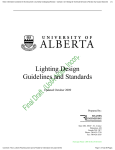
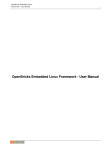
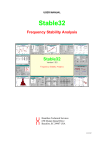
![User Manual [PDF 779 kB]](http://vs1.manualzilla.com/store/data/005781460_1-49b4dd0a8e6377162bdb6a1daefcc9f3-150x150.png)
